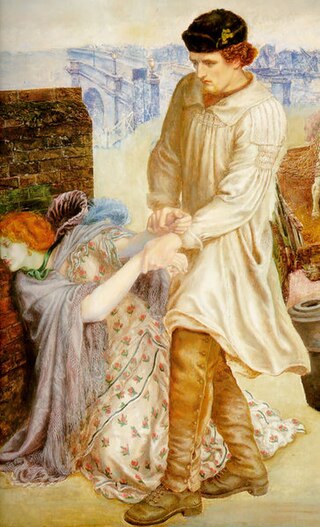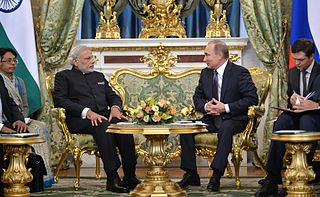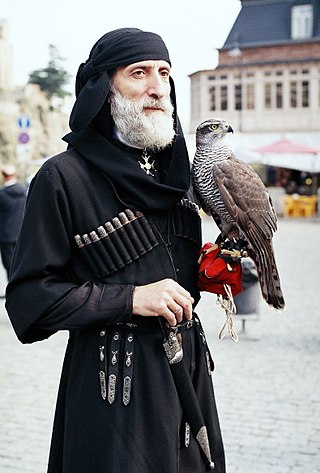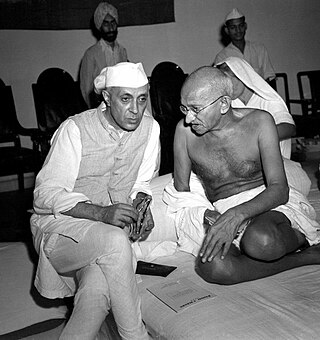
A kurta is a loose collarless shirt or tunic worn in many regions of South Asia, and now also worn around the world. Tracing its roots to Central Asian nomadic tunics, or upper body garments, of the late-ancient- or early-medieval era, the kurta has evolved stylistically over the centuries, especially in South Asia, as a garment for everyday wear as well as for formal occasions.

Formal wear or full dress is the Western dress code category applicable for the most formal occasions, such as weddings, christenings, confirmations, funerals, Easter and Christmas traditions, in addition to certain state dinners, audiences, balls, and horse racing events. Generally permitted other alternatives, though, are the most formal versions of ceremonial dresses, full dress uniforms, religious clothing, national costumes, and most rarely frock coats. In addition, formal wear is often instructed to be worn with official full size orders and medals.

The Nehru jacket is a hip-length tailored coat for men or women, with a mandarin collar, and with its front modelled on the Indian achkan or sherwani, a garment worn by Jawaharlal Nehru, the prime minister of India from 1947 to 1964.
Clothing in India varies with the different ethnicities, geography, climate, and cultural traditions of the people of each region of India. Historically, clothing has evolved from simple garments like kaupina, langota, achkan, lungi, sari, to rituals and dance performances. In urban areas, western clothing is common and uniformly worn by people of all social levels. India also has a great diversity in terms of weaves, fibers, colors, and the material of clothing. Sometimes, color codes are followed in clothing based on the religion and ritual concerned. The clothing in India also encompasses a wide variety of Indian embroidery, prints, handwork, embellishments, and styles of wearing clothes. A wide mix of Indian traditional clothing and western styles can be seen in India.

Frock has been used since Middle English as the name for an article of clothing, typically coat-like, for men and women.
Clerical clothing is non-liturgical clothing worn exclusively by clergy. It is distinct from vestments in that it is not reserved specifically for use in the liturgy. Practices vary: clerical clothing is sometimes worn under vestments, and sometimes as the everyday clothing or street wear of a priest, minister, or other clergy member. In some cases, it can be similar or identical to the habit of a monk or nun.
Clothing terminology comprises the names of individual garments and classes of garments, as well as the specialized vocabularies of the trades that have designed, manufactured, marketed and sold clothing over hundreds of years.

A smock-frock or smock is an outer garment traditionally worn by rural workers, especially shepherds and waggoners. Today, the word smock refers to a loose overgarment worn to protect one's clothing, for instance by a painter.

A Jodhpuri suit or Bandhgala suit, is a formal suit from India. It originated in the Jodhpur State, and was popularized during mid 19th - mid 20th century in India. It consists of a coat and trousers, sometimes accompanied by a vest. It brings together a shorter cut with hand-embroidery escorted by the waistcoat. It is suitable for occasions such as weddings and formal gatherings.

Achkan, also known as Baghal bandi, is a knee length jacket worn by men in the Indian subcontinent much like the Angarkha.

A chokha, also known as a cherkeska, is a woolen coat with a high neck that is part of the traditional male dress of peoples of the Caucasus. It was in wide use among Avars, Abazins, Abkhazians, Azerbaijanis, Balkars, Chechens, Circassians, Georgians, Ingush, Karachays, Kumyks, Nogais, Ossetians, Tats, the peoples of Dagestan, as well as Terek, Kuban Cossacks, Eastern Armenians who adopted it from the aforementioned peoples.
Churidars, also churidar pyjamas, are tightly fitting trousers worn by both men and women in the Indian subcontinent. Churidars are a variant of the common shalwar pants. Shalwars are cut wide at the top and narrow at the ankle. Churidars narrow more quickly so that contours of the legs are revealed. They are usually cut on the bias, making them naturally stretchy, which is important when pants are closefitting. They are also longer than the leg and sometimes finish with a tightly fitting buttoned cuff at the ankle. The excess length falls into folds and appears like a set of bangles resting on the ankle. When the wearer is sitting, the extra material is the "ease" that makes it possible to bend the legs and sit comfortably. The word churidar is from Hindi and made its way into English only in the 20th century. Earlier, tight-fitting churidar-like pants worn in India were referred to by the British as Moghul breeches, long-drawers, or mosquito drawers.
Pakistani clothing refers to the ethnic clothing that is typically worn by people in the country of Pakistan and by Pakistanis. Pakistani clothes express the culture of Pakistan, the demographics of Pakistan, and cultures from Punjab, Sindh, Balochistan, Khyber Pakhtunkhwa, Gilgit-Baltistan, and Kashmir regions of the country. The clothing in each region and culture of Pakistan reflect weather conditions, way of living, the textiles and embroidery used and its distinctive style which gives it a unique identity among all cultures.
A man's suit of clothes, in the sense of a lounge or business or office suit, is a set of garments which are crafted from the same cloth. This article discusses the history of the lounge suit, often called a business suit when featuring dark colors and a conservative cut.

Shalwar kameez is a traditional combination dress worn by women, and in some regions by men, in South Asia, and Central Asia.

Punjabi Kurta and Tamba are traditional costume for men of Punjab.

In the ancient Punjab region, people wore cotton clothing. Both men and women wore knee-length tops. A scarf was worn over the tops which would be draped over the left shoulder and under the right. A large sheet would be further draped over one shoulder which would hang loose towards the knees. Both male and female wore a dhoti around the waist. Modern Punjabi dress has retained this outfit but over its long history has added other forms of dress.

History of clothing in the Indian subcontinent The history of Indian clothing is deeply rooted in ancient civilizations, notably the Vedic and Indus Valley Civilization. Standard clothing in India can be traced back to these periods, around 5000 BCE, where evidence suggests the use of woven cotton fabric and the cultivation of silk from silkworms. The attire during this era included robes for priest-kings, turbans for men, knee-length skirts for women, and various jewelry like bangles, necklaces and other jewelry. The remnants of the ancient Indian clothing can be found in the various beautiful figurines discovered from the ancient and pre-historic sites, the rock-cut sculptures, the cave paintings, and human art forms found in temples and monuments. The vedic and other ancient scriptures also provide detailed information about the clothing in ancient period. Taking the instances of the sari to that of turban and the dhoti, the traditional Indian wears were mostly tied around the body in various ways.

Angarkha is a luxurious and traditional Indian garment that has been worn for centuries, particularly in northern regions of the country. At its core, the Angarkha is a long tunic, robe or coat that is worn both as a standalone piece and also worn over other garments. It was also used as an outer robe with long sleeves in South Asia. By the 19th-century it had become the generally accepted attire of an educated man in public. It had evolved from the Persian cape balaba or chapkan as a result of being given a more Indian form in the late medieval or early modern era.

Sadri, also known as a Waskat or Bandi, is a vest-jacket worn by men in South Asia, while women sometimes wear a similar waistcoat known as a Koti. In Europe and America, the sadri became known as a Nehru vest.





















